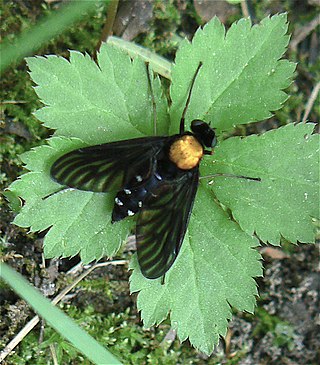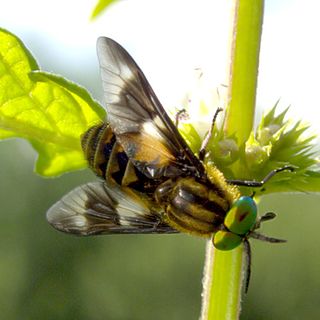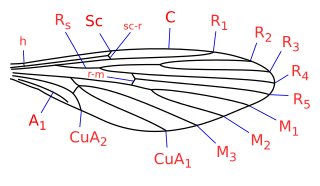
Psychodidae, also called drain flies, sink flies, filter flies, sewer flies, or sewer gnats, is a family of true flies. Some genera have short, hairy bodies and wings, giving them a "furry" moth-like appearance, hence one of their common names, moth flies. Members of the sub-family Phlebotominae, which are hematophagous, may be called sand flies in some countries, although this term is also used for other unrelated flies.

Chrysopilus is common, worldwide genus of predatory snipe flies. There are approximately 300 species in the genus, including fossil members that are sometimes found in amber.

The Lauxaniidae are a family of acalyptrate flies. They generally are small flies with large compound eyes that often are brightly coloured in life, sometimes with characteristic horizontal stripes, such as in Cestrotus species. Many species have variegated patterns on their wings, but in contrast they generally do not have variegated bodies, except for genera such as Cestrotus, whose camouflage mimics lichens or the texture of granitic rocks.

The Cranaidae are a family of neotropical harvestmen within the suborder Laniatores.

Superfamily Tabanoidea are insects in the order Diptera.

The Psychodinae are the nominate subfamily of moth flies (Psychodidae), also known as drain flies. Like most of their relatives, they are usually found in damp habitats; some occur in caves. The small larvae are aquatic or semi-terrestrial; the adults are winged and capable of flight. Psychodinae are found worldwide, including some subantarctic islands.
Pseudohercostomus is a genus of flies in the family Dolichopodidae. It is distributed in the Oriental and Afrotropical realms as well as Chile.
Austroleptis is a genus of snipe flies, and the sole genus in the family Austroleptidae; until 2010, it was placed in the family Rhagionidae. They are small to moderately sized flies of around 3 to 7.7 mm.
Atherimorpha is a genus of snipe fly of the family Rhagionidae.

Parathalassiinae is a subfamily of flies in the family Dolichopodidae. It is part of an extended concept of the family, Dolichopodidae sensu lato, and forms a monophyletic group with Dolichopodidae sensu stricto. It was once placed provisionally in the subfamily Microphorinae as the tribe Parathalassiini.
Boreofairchildia nearctica, the sugarfoot moth-fly, is a species of nematoceran flies in the family Psychodidae. It is endemic to the United States.

Nemopalpus is a genus of moth fly in the family Psychodidae, in the subfamily Bruchomyiinae. Recently (2018) a number of similar species have been transferred to the genera: Alexanderia, Boreofairchildia, Laurenceomyia and Notofairchildia. In Macquart's original publication, the genus name was spelled both as Nemopalpus and Nemapalpus, but Macquart corrected the error in 1839.

Philosepedon is a genus of flies belonging to the family Psychodidae.
Boreofairchildia is a genus of moth flies in the subfamily Bruchomyiinae. Species have been recorded from the Americas, principally Central and South America, with many, including the type, transferred from the genus Nemopalpus.

The subfamily Bruchomyiinae contains genera of moth flies in the order Diptera, was originally described by the American entomologist Charles Paul Alexander.

Notofairchildia is a genus of moth flies in the subfamily Bruchomyiinae. Species have been recorded principally from South America, with many, including the type, transferred from the genus Nemopalpus.
Alexanderia is a genus of moth flies in the subfamily Bruchomyiinae. This genus circumscribes species from south-east Asia, with three including the type, transferred from the genus Nemopalpus.
Bruchomyia is a genus of moth flies in the subfamily Bruchomyiinae. Species have been recorded principally from South America.

Eutonnoiria is a monotypic genus of moth flies in the subfamily Bruchomyiinae.











